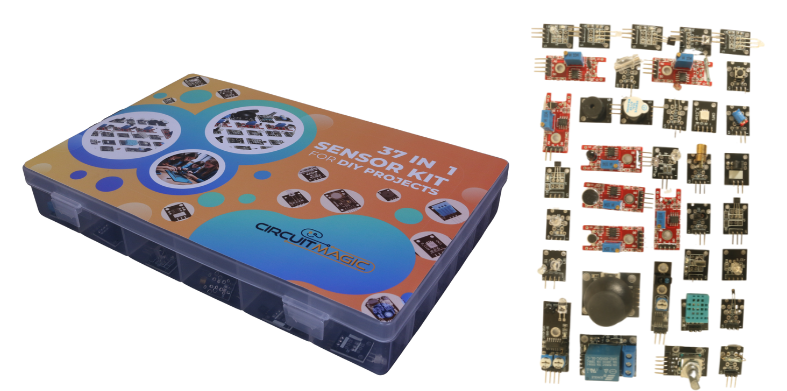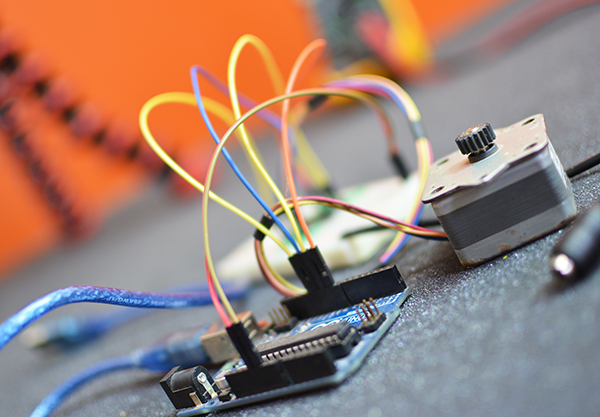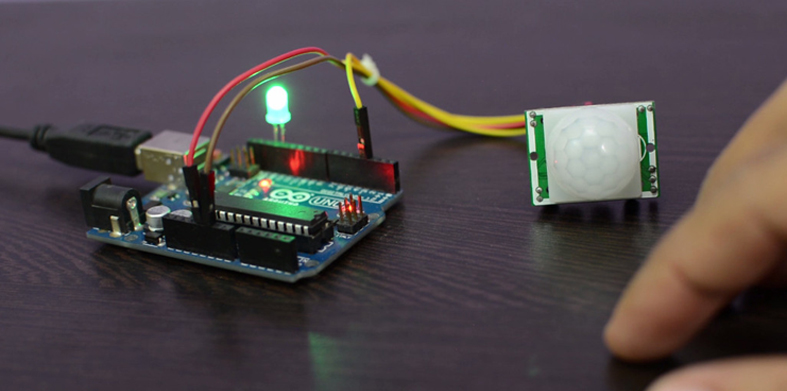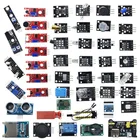This sensor kit contains 37 types of commonly used sensor modules for microcontroller projects, including modules like the active buzzer, 5V relay, temperature and humidity sensor, and more. It is compatible with various microcontrollers such as Arduino, Raspberry Pi, NodeMcu, and many others.
We also provide a step-by-step guide and detailed projects for each sensor, explaining their uses, wiring diagrams, and code. This will help you understand these sensor modules better and apply them to your interactive projects.
Temperature sensor

The DS18B20 is a digital temperature sensor module known for its high accuracy and simplicity of use. It is widely used in various applications, including weather monitoring, industrial automation, home automation, and electronic projects.
SMD RGB

SMD RGB module is a specialized module designed to work seamlessly with Arduino microcontrollers and similar development boards. It typically consists of three individual surface-mount RGB LEDs and a built-in controller that simplifies the process of controlling the colors and brightness of the LEDs. These modules often come with pre-soldered header pins, allowing for easy connection to Arduino boards.
Ball Switch

The Ball Switch module is a sensor module specifically designed to detect tilt or movement. It consists of a small metal ball inside a casing with two conductive pins. When the module is tilted or moved, the metal ball makes contact with the conductive pins, completing the circuit and triggering an electrical signal.
7 Color Flash

The “7 Color Flash” for Arduino typically refers to an RGB LED module capable of displaying seven different colors. This module features a compact design and is equipped with a built-in RGB LED that can emit various colors by combining different intensities of red, green, and blue light.
Two Color LED

A Two-Color LED module is a simple electronic component that integrates two LEDs of different colors into a single package. These LEDs are typically arranged side by side, allowing you to control each color independently. The most common configurations include red and green, red and blue, or green and blue LEDs.
Small Sound Sensor

A Small Sound Sensor is a compact electronic component designed to detect sound or sound-related changes in its surroundings. This type of sensor is also commonly known as a sound module, sound detector, or sound sensor module.
Line Tracking Module

A Line Tracking Sensor Module is a specialized electronic component designed to detect and follow lines or paths on a surface. It is commonly used in robotics and automation projects to create line-following robots or vehicles.
Tap Sensor Module

A Tap Sensor Module is an electronic component designed to detect physical taps or knocks and convert them into electrical signals. These modules are commonly used in interactive projects where you want to trigger actions or events based on taps or gentle touches.
Reed Switch Module

A Reed Switch Module an electronic component designed to detect the presence or absence of a magnetic field. It is based on a reed switch, which is a small switch made up of two ferromagnetic blades (reeds) inside a glass tube that come into contact or separate in the presence of a magnetic field.
Buzzer Module

A Buzzer Module is a simple electronic component designed to produce sound or generate tones when connected to an Arduino board. It is essentially a piezo buzzer or a small speaker integrated into a compact module, making it easy to use in various Arduino projects.
Passive Buzzer Module

A Passive Buzzer Module is an electronic component that functions as a sound transducer, producing sound without the need for an external driver or oscillator circuit. It is a type of buzzer that generates sound when a changing voltage is applied to it.
Photoresistor Sensor Module

A Photoresistor Sensor Module is an electronic component that measures the intensity of light in its surroundings. It is also known as a Light Dependent Resistor (LDR) module. The photoresistor is a type of resistor whose resistance decreases as the amount of light incident on it increases.
Digital Temp Sensor

A Photoresistor Sensor Module is an electronic component that measures the intensity of light in its surroundings. It is also known as a Light Dependent Resistor (LDR) module. The photoresistor is a type of resistor whose resistance decreases as the amount of light incident on it increases.
Light Blocking

It seems like you are referring to a module that can detect light or its absence (i.e., darkness) to block or unblock a certain action or process controlled by an Arduino. Such a module can be used in various applications, such as automatic lighting systems, security systems, and more..
Mini Reed Sensor

A mini reed sensor is a type of magnetic sensor that consists of a small switch encased in a glass tube. It is designed to be sensitive to magnetic fields and can be used to detect the presence or absence of a magnetic field, such as that generated by a magnet. Reed sensors are commonly used in various applications, including door and window sensors, liquid level detectors, and more.
Flame Sensor

A flame sensor is a module used to detect the presence of fire or a flame. It can be a crucial component in fire detection and safety systems. There are different types of flame sensors, but the most common one used with Arduino is the IR (Infrared) flame sensor. This type of sensor detects the infrared radiation emitted by flames.
Hall Effect Magnetic Sensor

A Hall Effect sensor is a type of magnetic sensor that can detect the presence and strength of a magnetic field. It works based on the Hall Effect, which is the production of a voltage difference (Hall voltage) across an electrical conductor when subjected to a perpendicular magnetic field and an electric current. Hall Effect sensors are commonly used in various applications, including proximity sensing, speed detection, and current measurement
Temp and Humidity

To measure temperature and humidity, one of the most commonly used sensors is the DHT series, such as the DHT11 and DHT22 sensors. These sensors provide both humidity and temperature readings. I’ll provide instructions for both sensors, and you can choose the one that best fits your requirements
Big Sound

The Big Sound Sensor Module, also known as a Sound Detector Module, is a sensor that can detect sound and noise levels in its surroundings. It converts sound vibrations into electrical signals, making it useful for sound-activated projects, noise monitoring systems, and interactive audio applications.
Linear Hall

A Linear Hall Effect sensor is a type of Hall Effect sensor that can measure the strength and direction of a magnetic field. Unlike the traditional Hall Effect sensors used for proximity sensing, a Linear Hall Effect sensor provides an analog output voltage that is proportional to the strength of the magnetic field it detects.
Analog Hall

An Analog Hall Effect sensor is a type of sensor that measures the strength and polarity of a magnetic field and provides an analog voltage output that is proportional to the magnetic field it detects. These sensors are often used in applications where a continuous and precise measurement of the magnetic field is required, such as in current sensing, position sensing, and rotational speed sensing.
Obstacle Avoidance Sensor

An obstacle avoidance sensor is a type of sensor used to detect the presence of obstacles or objects in its surroundings. These sensors are commonly used in robotics, drones, autonomous vehicles, and other applications where avoiding collisions with obstacles is essential
Button

An obstacle avoidance sensor is a type of sensor used to detect the presence of obstacles or objects in its surroundings. These sensors are commonly used in robotics, drones, autonomous vehicles, and other applications where avoiding collisions with obstacles is essential
Laser Emitter/ Laser Transmitter Module

The Laser Transmitter Module is a small module that contains a laser diode and a driver circuit to control the laser emission. It is often used in various hobby projects, such as laser-based communication, distance measurement, and laser pointers. Please note that laser modules, including the KY-008, emit visible or infrared light and can be harmful to the eyes. Always use laser modules with caution and avoid direct exposure of the laser beam to the eyes or skin
Shock Sensor

A shock sensor, also known as a vibration sensor or an impact sensor, is a type of sensor that detects sudden physical impacts or vibrations. It is commonly used in various applications for security, monitoring, and safety purposes.
Shock sensors are designed to respond to rapid changes in acceleration or movement, which occur when an object is struck or experiences a sudden shock. When a shock is detected, the sensor sends a signal or triggers an alarm to alert the system or the user about the event.
IR Receiver Sensor

An IR (Infrared) Receiver sensor, also known as an IR Receiver module or IR Sensor module, is a sensor that detects infrared signals from an IR transmitter. These sensors are commonly used in remote control applications, proximity sensing, and object detection.
RGB LED Module

An RGB 3-Color LED Module is a complete package that includes a Red, Green, Blue (RGB) LED along with the necessary circuitry to control and mix the colors of the LED easily. It typically has four pins: one for each of the three colors (R, G, B) and a common cathode or common anode pin.
Light Cup Module

The Magic Light Cup module is a small electronic module that features a color-changing RGB LED inside a transparent cup-like enclosure. It is also known as the “Magic Light Cup” or “Magic Cup Lamp” module. The module is designed to create a colorful and mesmerizing visual effect when powered on
IR Emission Module

Infrared sensor module designed to emit infrared light or signals. It is commonly used in various applications, including remote control systems, communication, and object detection.
Heartbeat Sensor
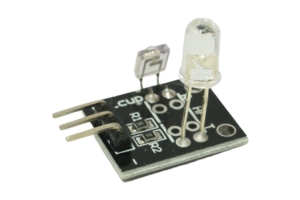
A heartbeat sensor, also known as a heart rate sensor or pulse sensor, is used to measure heart rate or pulse rate. It detects the rhythmic pulsation of blood in blood vessels, typically in the fingertip or earlobe, and converts it into an electrical signal that can be measured and displayed
Tilt Switch Sensor

A tilt switch sensor is a type of sensor that detects the orientation or tilting of an object. It is a simple and widely used sensor that can be found in various applications, including security systems, toys, electronic devices, and automation projects.
Two Color Sensor

A “Two Color sensor” is a type of sensor that can distinguish between two specific colors. These sensors are commonly used in various applications, such as color detection, sorting, and quality control in industrial settings.
Touch Sensor

A touch sensor is an electronic device that detects physical touch or proximity to a surface. Touch sensors are designed to sense touch inputs and convert them into electrical signals that can be interpreted by electronic systems, such as microcontrollers or touch controller ICs. Capacitive touch sensors detect touch by measuring changes in capacitance when a conductive object (like a finger) comes close to the sensor surface. These sensors are commonly used in smartphones, tablets, touchscreens, and touch-sensitive buttons.
Rotary Encoders

Rotary encoders are electromechanical devices used to measure the angular position and rotation of an object. They convert the rotational motion of an axis into an electrical signal that can be interpreted by electronic systems, such as microcontrollers or digital devices.
Joy Stick

A joystick sensor, also known simply as a joystick or joystick module, is an input device that allows users to control the movement of an object or cursor on a screen. It consists of a movable lever (stick) that can be tilted in various directions, and it provides positional information based on the direction and amount of tilt applied to the stick.
Joystick sensors are commonly used in gaming controllers, remote-controlled vehicles, robotics, virtual reality applications, and other interactive systems where precise control of movement is required.
Relay

A relay is an electromechanical device used to control the flow of electric current between two or more circuits. It operates as a switch that is controlled by an electrical signal, typically from a low-power source like a microcontroller or sensor. Relays are widely used in various applications to control high-power devices or circuits using lower-power control signals.

